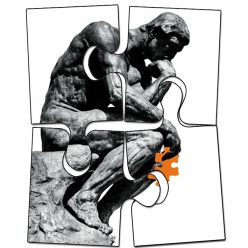If I Were a Rich Man
By Vern Gowdie in Gold Coast, Australia
With Christmas approaching, it’s time to step back from the market action and take stock of what’s really important in life.
Fiddler on the Roof was released in 1971. The movie won three Academy Awards.
Tevye, the main character, is a poor dairyman in 20th century Russia. He is the father of five daughters. Tevye talks to God a lot about the difficulties of raising family, religion, traditions and being poor.
In one scene he sings about what it’d be like…
‘If I were a rich man,
Ya ha deedle deedle, bubba bubba deedle deedle dum.
All day long I’d biddy biddy bum.
If I were a wealthy man.
I wouldn’t have to work hard.
Ya ha deedle deedle, bubba bubba deedle deedle dum.
If I were a biddy biddy rich,
Yidle-diddle-didle-didle man.’
Tevye thinks that if he were a wealthy man he wouldn’t have to work hard.
Perhaps.
Another verse from the song is:
‘I’d build a big tall house with rooms by the dozen,
Right in the middle of the town.
A fine tin roof with real wooden floors below.
There would be one long staircase just going up,
And one even longer coming down,
And one more leading nowhere, just for show.’
Tevye’s dreams are the same as the majority who fantasise over scoring it big…the lotto win or backing the hot cryptocurrency.
Ah, the rewards that await. Bigger house. No more work. A life of leisure awaits.
Dreams and reality often don’t align.
I learnt this first hand from Dr Joanne Stern PhD.
Joanne is a psychologist based in Aspen, Colorado and the author of Parenting Is a Contact Sport: 8 Ways to Stay Connected to Your Kids for Life.
Aspen and its surrounds are home to some of the wealthiest people in America. Aspen is proof ‘money does not buy happiness’. Joanne told me the divorce rate, suicide and drug dependency issues in Aspen are all well above the national average.
Joanne has shared with me a number of stories about the wealthy families she’s counseled over the years. Jealousy, lack of affection, parental remoteness, greed, resentment, idleness, infidelity, manipulative in-laws — are all some of the issues that provide Joanne with a steady stream of clients.
At Port Phillip Publishing our every endeavour is focused on assisting you to create and retain wealth. Making smarter investment choices. Providing a different perspective on the global economy. Designing strategies that best suit your risk profile and stage in life.
However, it must be remembered that having money is only part of the well-being equation. Emotional stability is equally as important. A rich life is measured in much broader terms than your bank balance.
Numerous research papers looking at the connection between money and happiness conclude that more money does not equal greater happiness.
There’s no question money does afford a higher standard of living — better schools, a safer neighbourhood and access to better health care.
This explains why the middle class tends to rank higher on the happiness scale compared to those living in poverty.
However, there is not a quantum leap in happiness between those in the middle class and the wealthy. In fact, some studies suggest a percentage of the wealthy are downright miserable…on par in the emotional stakes with those in poverty.
The worry of having money — who is after it? Are they really my friends? What do they want? Can I trust them? What happens if I lose it? Is that in-law a gold digger?
The constant second guessing can be exhausting and in turn can lead to (varying degrees of) paranoia for some wealthy people.
As the old saying goes: ‘if you are going to be unhappy, then you might as well be rich and unhappy.’
However our aim is to provide you with the skill set to assist you in having ‘your cake and eat it too’ — wealth and happiness.
Another well used saying is: ‘It’s all about the journey, not the destination’.
Taking stock of what you have and not lamenting what you don’t is critical to achieving inner peace and happiness.
If you covet what other people have, you’ll live a life of filled with bouts of jealousy and misery — unless you’re Jeff Bezos (Amazon founder and the world’s wealthiest person) there is always going to be someone with more than you.
Things that are important to and contribute to emotional wellbeing are:
- Family — all the money in the world cannot buy love and respect. Losing the love and respect of my wife, three daughters and my closest family members would, to me, be a fate far worse than losing money.
- Health — money could not buy Kerry Packer good health. Appreciating the ability to rise and shine each morning is a blessing that should not be taken for granted. Treasure your health because without it your wealth is very much a secondary consideration.
- Employment — being engaged in a profession/occupation/business that excites you and is fulfilling, this creates a sense of wellbeing and self-worth. Do something you’re passionate about and you’ll never work a day in your life. You may not love your work, but at least be thankful for being employed and endeavour to be the best you can be at what you do.
- Friends — good friends are worth more than their weight in gold. True friendships should be cherished and nurtured. If all else fails, true friends will always be there for you. Last Saturday night, I celebrated 50 years of mateship with five friends (we started Grade 5 together in 1969)…it was a timely reminder of how special friends are to our well-being.
- Australia — we are indeed a lucky country. First world health. Freedom of speech. Tolerance. Clean fresh water. Great food. Excellent wines. Fantastic weather. Reasonably sound economy. Peace. Mineral wealth. Agriculture. Often times we lose perspective and whinge and moan about certain issues, but in reality, we have a whole lot to be thankful for in this country.
If we take time to stand back and apply a little perspective, there’s a lot of richness in our lives. Constantly reminding ourselves to be grateful for what we have is a constructive way to stay grounded for when the monetary rewards do flow our way.
Here’s some Festive Season tips to assist in building the wealth to go along you’re your gift of health and happiness:
- Financial Plan — identify your short, medium and long term financial goals. Clearly defined goals with realistic savings projections are far more likely to be achieved. The success rate of implementing a plan with believable and achievable goals is guaranteed to be higher than simply wishing ‘to be a rich man’.
- Budget — Live within your means. Don’t try to impress people you don’t know, with things you don’t need, purchased with money you don’t have. In the coming months/years the greatest credit bubble in history is going to bust. An entire generation accustomed to borrowing from the future to live a life of excess today are going to encounter a very unpleasant reality check. Act today to bring your household expenditure into line with what you earn and avoid the painful lesson that awaits so many of your peers.
- Avoid Debt — where possible you should avoid debt, especially for consumption purposes. Debt is simply an advance on tomorrow’s income. Low interest rates make larger amounts of debt affordable. This is the trap the authorities want you to fall into…borrow more to keep the debt-dependent economic model in motion. Don’t fall for it. With the end of the debt super-cycle in sight, being prudent has never been more important.
- Think a lot and act a little — all the very successful people I know do an extraordinary amounts of research (on purchases related to property, motor vehicles, shares etc.) before they act. There’s a fine line between doing too much research, leading to ‘analysis paralysis’ and not doing enough, that results in ‘acting in haste and repenting in leisure’. Do sufficient research to be comfortable with the decision you make and always build in a contingency plan. One question to ask yourself is ‘am I following the crowd or am I thinking independently?’ If you are following the latest trend, chances are it’ll turn out to be a bad decision.
- On balance make good financial decisions — It’s impossible to make every investment decision a winner. The trick is to minimise the losses. This is where ‘think a lot and act a little’ comes into play. Do your research. Listen to your inner voice. And remember ‘if it sounds too good to be true, it usually is’. Sometimes the best investments you make are the ones you do not proceed with.
Our daily newsletters and subscription services are here to assist you in your journey to a rich life — rich in knowledge, rich in personal wellbeing, rich in shared experiences, rich in sound investment choices and hopefully, rich in enjoyment.
Be thankful for what you have. Commit to building on your current base of knowledge and wealth. And enjoy each day for the experiences, lessons and beauty it has to offer.
Do this and you will truly be a ‘rich man or woman’.
Regards
Vern Gowdie,
Editor, The Gowdie Letter







